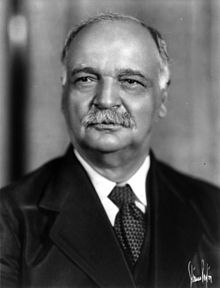Charles Curtis | |||||||||||||||||||||||||||||||||||||||||||||||||||
|---|---|---|---|---|---|---|---|---|---|---|---|---|---|---|---|---|---|---|---|---|---|---|---|---|---|---|---|---|---|---|---|---|---|---|---|---|---|---|---|---|---|---|---|---|---|---|---|---|---|---|---|
 Curtis, c. 1920s | |||||||||||||||||||||||||||||||||||||||||||||||||||
| 31st Vice President of the United States | |||||||||||||||||||||||||||||||||||||||||||||||||||
| In office March 4, 1929 – March 4, 1933 | |||||||||||||||||||||||||||||||||||||||||||||||||||
| President | Herbert Hoover | ||||||||||||||||||||||||||||||||||||||||||||||||||
| Preceded by | Charles G. Dawes | ||||||||||||||||||||||||||||||||||||||||||||||||||
| Succeeded by | John Nance Garner | ||||||||||||||||||||||||||||||||||||||||||||||||||
| |||||||||||||||||||||||||||||||||||||||||||||||||||
| United States Senator from Kansas | |||||||||||||||||||||||||||||||||||||||||||||||||||
| In office March 4, 1915 – March 3, 1929 | |||||||||||||||||||||||||||||||||||||||||||||||||||
| Preceded by | Joseph L. Bristow | ||||||||||||||||||||||||||||||||||||||||||||||||||
| Succeeded by | Henry Justin Allen | ||||||||||||||||||||||||||||||||||||||||||||||||||
| In office January 29, 1907 – March 3, 1913 | |||||||||||||||||||||||||||||||||||||||||||||||||||
| Preceded by | Alfred W. Benson | ||||||||||||||||||||||||||||||||||||||||||||||||||
| Succeeded by | William Howard Thompson | ||||||||||||||||||||||||||||||||||||||||||||||||||
| Member of the U.S. House of Representatives from Kansas | |||||||||||||||||||||||||||||||||||||||||||||||||||
| In office March 4, 1893 – January 28, 1907 | |||||||||||||||||||||||||||||||||||||||||||||||||||
| Preceded by | Case Broderick | ||||||||||||||||||||||||||||||||||||||||||||||||||
| Succeeded by | James Monroe Miller | ||||||||||||||||||||||||||||||||||||||||||||||||||
| Constituency |
| ||||||||||||||||||||||||||||||||||||||||||||||||||
| Personal details | |||||||||||||||||||||||||||||||||||||||||||||||||||
| Born | January 25, 1860 North Topeka, Kansas Territory, U.S. | ||||||||||||||||||||||||||||||||||||||||||||||||||
| Died | February 8, 1936 (aged 76) Washington, D.C., U.S. | ||||||||||||||||||||||||||||||||||||||||||||||||||
| Resting place | Topeka Cemetery | ||||||||||||||||||||||||||||||||||||||||||||||||||
| Nationality | American Kaw Nation | ||||||||||||||||||||||||||||||||||||||||||||||||||
| Political party | Republican | ||||||||||||||||||||||||||||||||||||||||||||||||||
| Spouse |
Annie Baird
(m. 1884; died 1924) | ||||||||||||||||||||||||||||||||||||||||||||||||||
| Children | 3 | ||||||||||||||||||||||||||||||||||||||||||||||||||
| Relatives | White Plume (great-great-grandfather) White Hair (great-great-great-grandfather) | ||||||||||||||||||||||||||||||||||||||||||||||||||
| Signature | |||||||||||||||||||||||||||||||||||||||||||||||||||
| Nickname | "Indian Charlie"[1] | ||||||||||||||||||||||||||||||||||||||||||||||||||
Charles Curtis (January 25, 1860 – February 8, 1936) was an American attorney and Republican politician from Kansas who served as the 31st vice president of the United States from 1929 to 1933 under Herbert Hoover and the Senate Majority Leader from 1924 to 1929. A member of the Kaw Nation born in the Kansas Territory, Curtis was the first Native American to serve in the United States Congress, where he served in the United States House of Representatives and Senate before becoming Senate Majority Leader. Curtis also was the first Native American to serve as Vice President.
Curtis believed that Native Americans could benefit from mainstream education and assimilation. He entered political life when he was 32 years old and won several terms from his district in Topeka, Kansas, beginning in 1892 as a Republican to the U.S. House of Representatives. There, he sponsored and helped pass the Curtis Act of 1898, which extended the Dawes Act to the Five Civilized Tribes of the Indian Territory. Despite Curtis being unhappy with the final version of it, implementation of the Act completed the ending of tribal land titles in the Indian Territory and prepared the larger territory to be admitted as the State of Oklahoma in 1907. The government tried to encourage Indians to accept individual citizenship and lands and to take up European-American culture.
Curtis was elected to the U.S. Senate first by the Kansas Legislature in 1906 and then by popular vote in 1914, 1920, and 1926. Curtis served one six-year term from 1907 to 1913 and then most of three terms from 1915 to 1929, when he was elected as vice-president. His long popularity and connections in Kansas and federal politics helped make Curtis a strong leader in the Senate. He marshaled support to be elected as Republican Whip from 1915 to 1924 and then as Senate Majority Leader from 1924 to 1929. In those positions, he was instrumental in managing legislation and in accomplishing Republican national goals.
Curtis ran for vice president alongside Herbert Hoover for president in 1928—winning a landslide victory. In 1932, he became the first United States vice president to open the Olympic Games. However, when Curtis and Hoover ran together again in 1932 during the Great Depression, they lost as the public gave the Democrats Franklin D. Roosevelt and John Nance Garner a landslide victory that year.
Curtis remains the highest-ranking enrolled Native American who ever served in the federal government. He is also the most recent officer of the executive branch to have been born in a territory, rather than a state or federal district. Kamala Harris became the second multiracial person to become vice president in 2021.
- ^ "Who Was Charles Curtis, the First Vice President of Color?". smithsonianmag.com. Retrieved February 16, 2024.